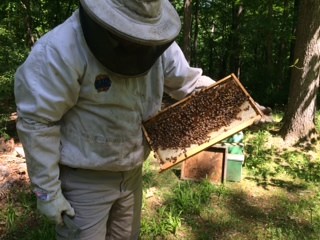A yearly survey of beekeepers, shows fewer colony losses occurred in the United States over the winter of 2013-2014 than in recent years, but beekeepers say losses remain higher than the level that they consider to be sustainable.
According to survey results, total losses of managed honey bee colonies from all causes were 23.2 percent nationwide. That number is above the 18.9 percent level of loss that beekeepers say is acceptable for their economic sustainability, but is a marked improvement over the 30.5 percent loss reported for the winter of 2012-2013, and over the eight-year average loss of 29.6 percent
“I lost five or six (colonies) over the most recent winter,” said Steve Gibson, a beekeeper who keeps 40 colonies and said his worst winter since he started a decade ago was 2011-2012. A colony consists of 8,000 to 12,000 individual bees.
Gibson is a retired agent with the N.C. Cooperative Extension Service and current program chairman of the Cleveland County Association of Bee Keepers, a consortium of about 60 members. The Polkville-area man also teaches a beekeeping class.
Gibson believes there is too much alarm about bee colony losses in the last decade. “In my opinion it’s not a crisis,” he said, adding that he sees blaming pesticides as a culprit in population declines as nothing more than a fad. “This fluctuation in numbers has been going on with bees since the history of beekeeping.” Entomologists, other scientists and lay beekeepers themselves have floated a number of theories in recent years about why honey bee populations are seeing so many losses, a phenomenon that has been given the broad name Colony Collapse Disorder, or CCD. Many have blamed pesticides, especially a new class of insect and pest killers called neonicotinoids, which some say is harmful to bee colonies even when administered at what is considered safe levels.
For others, the threat is mainly coming from other organisms such as the Varroa mite, which are thought to be killing off colonies directly and spreading deadly diseases. Others blame the prevalence of commercial farming, which relies on monocultures of commodity crops like wheat and corn, plants that provide little pollen for foraging bees. In this scenario, honeybees are believed to be literally starved of the necessary nutrition to maintain colonies year over year.
The honey bee plays a critical role in the pollination of dozens of fruits, nuts and vegetables, including apples, peaches, blueberries, almonds, cucumbers, okra, broccoli and watermelon.
The death rate for the most recent winter, October 2013 through April 2014, was better than the 30.5 percent loss reported for the winter of 2012-2013, but worse than the 21.9 percent in 2011-2012, the U.S.D.A. report said. Previous surveys found total colony losses averaged about 30 percent over the last eight-year span.
Over the past few years, bee populations have been dying at a rate the U.S. government says is economically unsustainable.
Agencies/Canadajournal
 Canada Journal – News of the World Articles and videos to bring you the biggest Canadian news stories from across the country every day
Canada Journal – News of the World Articles and videos to bring you the biggest Canadian news stories from across the country every day



